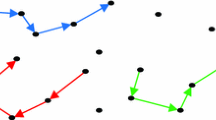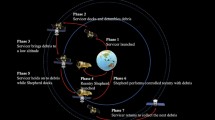Abstract
This paper investigates the cost requirement for a space debris collecting mission aimed at removing heavy debris from low Earth orbits. The problem mixes combinatorial optimization to select the debris among a list of candidates and functional optimization to define the orbital manoeuvres. The solving methodology proceeds in two steps: Firstly, a specific transfer strategy with impulsive manoeuvres is defined so that the problem becomes of finite dimension; secondly the problem is linearized around an initial reference solution. A Branch and Bound algorithm is then applied iteratively to optimize simultaneously the debris selection and the orbital manoeuvres, yielding a new reference solution. The optimal solutions found are close to the initial guess despite a very complicated design space. The method is exemplified on a representative application case.














Similar content being viewed by others
References
Klinkrad, K.: Space Debris Models and Risks Analysis. Springer, Berlin and Heidelberg (2006). ISBN: 3-540-25448-X
Liou, J.: An assessment of the current LEO debris environment and what needs to be done to preserve it for future generations. In: International Conference on Orbital Debris Removal, Brazil, Chantilly, Virginia (2008)
Position paper on space debris mitigation. In: International Academy of Astronautics (2005)
Walker, R., Martin, C.E., Stokes, P.H., Wilkinson, J.E.: Studies of space debris mitigation options using the debris environment long term analysis (DELTA) model. In: 51st International Astronautical Congress, Brazil, Rio de Janeiro, pp. IAA-00_IAA.6.6.07 (2000)
Bastida Virgili, B., Krag, H.: Strategies for active removal in LEO. In: 5th European Conference on Space Debris, Germany. ESOC, Darmstadt (2009)
Leitmann, G.: Optimization techniques. Math. Sci. Eng. 5 (1962)
Trélat, E.: Contrôle Optimal—Théorie et Applications. Vuibert, Paris (2005)
Lacomme, P., Prins, C., Sevaux, M.: Algorithmes de Graphes, 2ème edn. Eyrolles, Paris (2003)
Schneider, J.J., Kirkpatrick, S.: Stochastic Optimization. Springer, Berlin (2006)
Nemhauser, G.L., Rinnooy Kan, A.H.G., Todd, M.J.: Optimization. Handbooks in Operations Research and Management Science, vol. 1. Elsevier, Amsterdam (1989)
Minoux, M.: Programmation Mathématique—Théorie et Algorithmes, 2ème edn. Editions Tec&Doc, Lavoisier, Paris (2008)
Dréo, J., Pétrowski, A., Siarry, P., Taillard, E.: Métaheuristiques Pour L’optimisation Difficile. Eyrolles, Paris (2003)
Oberle, H.J., Taubert, K.: Existence and multiple solutions of the minimum-fuel orbit transfer problem. J. Optim. Theory Appl. 95, 243–262 (1997)
Gergaud, J., Haberkorn, T.: Orbital transfer: some links between the low-thrust and the impulse cases. Acta Astronaut. 60(6–9), 649–657 (2007)
Minieka, E.: On computing sets of shortest paths in a graph. Manag. Sci. Oper. Res. 17(6) (1974)
Eppstein, D.: Finding the k shortest paths. In: 35th IEEE Symp. Foundations of Comp. Sci., Santa Fe, 1994, pp. 154–165 (1997). Tech. Rep. 94-26
Hershberger, J., Maxel, M., Suri, S.: Finding the k shortest simple paths: a new algorithm and its implementation. ACM Trans. Algorithms 3(4) (2007)
Sedeno-Noda, A., Gonzalez-Martin, C.: On the k shortest path trees problem. Eur. J. Oper. Res. 202, 628–635 (2010)
Billionnet, A.: Optimisation Discrète. Dunod, Paris (2007)
Chao, C.: Applied Orbit Perturbation and Maintenance. The Aerospace Press, Reston (2005)
Chobotov, V.: Orbital Mechanics, 3rd edn. AIAA Education Series. AIAA, Washington (2002)
Murakami, J., Hokamoto, S.: Approach for optimal multi-rendezvous trajectory design for active debris removal. In: 61th International Astronautical Congress, Prague, CZ, pp. IAC-10.C1.5.8 (2010)
Chapman, S.J.: Fortran 90/95 for Scientists and Engineers, 2nd edn. McGraw-Hill, New York (2004)
Guéret, C., Prins, C., Sevaux, M.: Programmation Linéaire, 2ème edn. Eyrolles, Paris (2003)
Acknowledgements
This work was carried out at EADS Astrium Space Transportation in 2010–2011 in the frame of the internal R&D. I am very grateful to Emmanuel Trélat (UPMC, Paris) and Thomas Haberkorn (MAPMO, University of Orléans) for their support and advices in order to write down a comprehensive paper.
Author information
Authors and Affiliations
Corresponding author
Additional information
Communicated by Ryan P. Russell.
Rights and permissions
About this article
Cite this article
Cerf, M. Multiple Space Debris Collecting Mission—Debris Selection and Trajectory Optimization. J Optim Theory Appl 156, 761–796 (2013). https://doi.org/10.1007/s10957-012-0130-6
Received:
Accepted:
Published:
Issue Date:
DOI: https://doi.org/10.1007/s10957-012-0130-6




